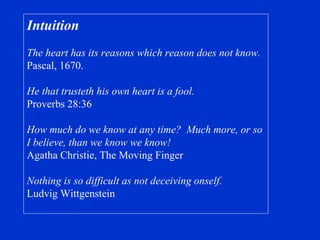Empfohlen
Empfohlen
Weitere ähnliche Inhalte
Ähnlich wie Intution
Ähnlich wie Intution (17)
10Consciousness© 2019 Cengage. All rights reserved.

10Consciousness© 2019 Cengage. All rights reserved.
10Consciousness© 2019 Cengage. All rights reserved.

10Consciousness© 2019 Cengage. All rights reserved.
Chapter 5QUESTION 1. If our sensory system receives in.docx

Chapter 5QUESTION 1. If our sensory system receives in.docx
Mehr von MADAN PANDIA
Mehr von MADAN PANDIA (20)
Right To Information And Civil Society Organisations

Right To Information And Civil Society Organisations
Intution
- 1. Intuition The heart has its reasons which reason does not know. Pascal, 1670. He that trusteth his own heart is a fool. Proverbs 28:36 How much do we know at any time? Much more, or so I believe, than we know we know! Agatha Christie, The Moving Finger Nothing is so difficult as not deceiving onself. Ludvig Wittgenstein
- 2. Intuition: does it exist? General consensus that it exists but we have been wrong before. . . . . earth is flat . . . sun travels around earth. . . .
- 7. Intuition: is it learned or innate? Has implications for training and assessment learning genetics Area of the individual needs H X W to exist
- 8. Intuition: what is it? Immediate insight without observation or reason Perception-like, rapid, effortless cognition leading to action Social intuition: sensing that something is not right Unconscious learning Complex pattern recognition Myers, D. G. (2002). Intuition: Its Powers and Perils . New Haven: Yale University Press.
- 10. Precedence exists “ However, the conviction remains that whenever we do use vision to become aware of objects or events, this must be accompanied by a corresponding visual experience. . . .The experiments reported here show that this belief is incorrect. In particular, some observers can consciously feel (or sense) a change in their surroundings even though they no visual experience of it. . . . “
- 11. “ Forty naïve observers were tested. Observers viewed the display and were asked to press a response key twice. The first response was to be given when they sense a change – that is, had a “feeling” that a change was occurring. The second response key was to be given when they saw the change – that is, had a visual experience sufficient for a verbal description of the changing item. . . .” Rensink, R. A. (2004). Visual Sensing Without Seeing. Psychological Science, 15 , 27-32.
- 12. Intuition: in controlled settings? Priming studies: Present a word on a screen (e.g., “bread”) too briefly for people to be able to verbally report the word – Then flash either “bubble” or “butter” briefly but slow enough that people can see it: Will see butter more easily (faster) than bubble Primed the word butter with a cue that person could not report seeing.
- 13. Intuition: how can we research it? Descriptive studies: Who : experienced vs rookie men and women equally? bad guys and good guys When: repeated or seldom ET “ instantaneous” vs. slow realization Where: alone or with partner situations of high/low risk situations of high/low emotions at work or “all the time” with constant or with changing environments
- 16. Intuition: how can we research it? Experimental studies: Manipulate antecedents and measure behavior E.g., person observes complex scene (with low or high density of cues) and track eye movement as a function of the cues moving around in that environment. Vary the characteristics of the person – test the expert as well as the novice.
- 17. “ Signal” “ Response” Present Absent No Yes Have no intuition and do not act. Have intuition and do not act. Have no intuition and still act. Have intuition and act on it.
- 18. Future Directions Research Recommendations Research Priorities

